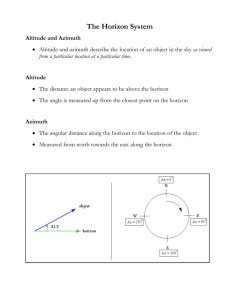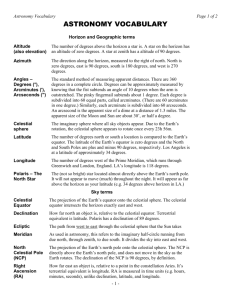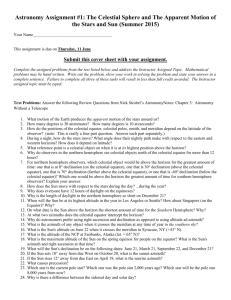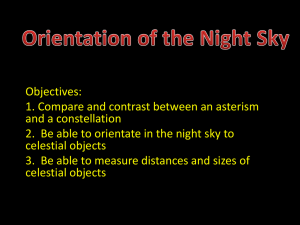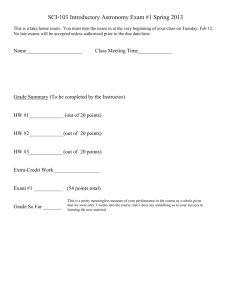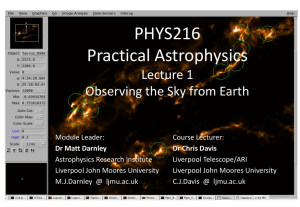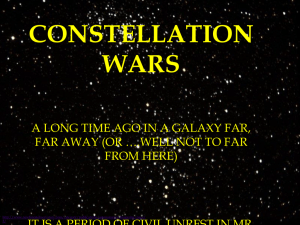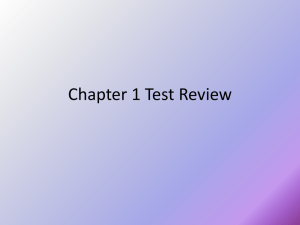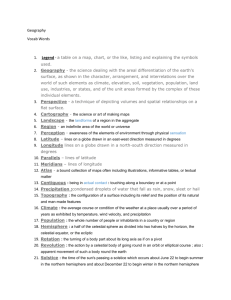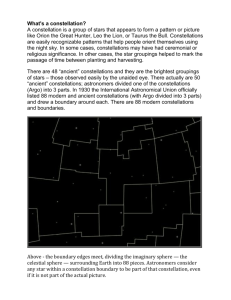lecture notes
advertisement
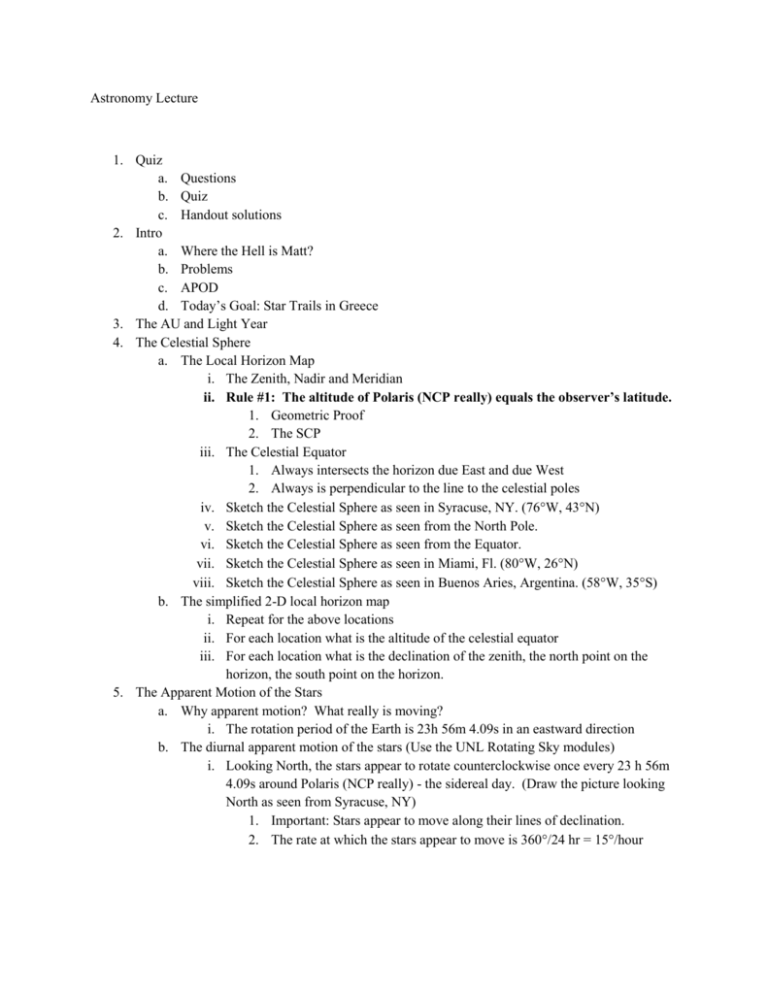
Astronomy Lecture 1. Quiz a. Questions b. Quiz c. Handout solutions 2. Intro a. Where the Hell is Matt? b. Problems c. APOD d. Today’s Goal: Star Trails in Greece 3. The AU and Light Year 4. The Celestial Sphere a. The Local Horizon Map i. The Zenith, Nadir and Meridian ii. Rule #1: The altitude of Polaris (NCP really) equals the observer’s latitude. 1. Geometric Proof 2. The SCP iii. The Celestial Equator 1. Always intersects the horizon due East and due West 2. Always is perpendicular to the line to the celestial poles iv. Sketch the Celestial Sphere as seen in Syracuse, NY. (76W, 43N) v. Sketch the Celestial Sphere as seen from the North Pole. vi. Sketch the Celestial Sphere as seen from the Equator. vii. Sketch the Celestial Sphere as seen in Miami, Fl. (80W, 26N) viii. Sketch the Celestial Sphere as seen in Buenos Aries, Argentina. (58W, 35S) b. The simplified 2-D local horizon map i. Repeat for the above locations ii. For each location what is the altitude of the celestial equator iii. For each location what is the declination of the zenith, the north point on the horizon, the south point on the horizon. 5. The Apparent Motion of the Stars a. Why apparent motion? What really is moving? i. The rotation period of the Earth is 23h 56m 4.09s in an eastward direction b. The diurnal apparent motion of the stars (Use the UNL Rotating Sky modules) i. Looking North, the stars appear to rotate counterclockwise once every 23 h 56m 4.09s around Polaris (NCP really) - the sidereal day. (Draw the picture looking North as seen from Syracuse, NY) 1. Important: Stars appear to move along their lines of declination. 2. The rate at which the stars appear to move is 360/24 hr = 15/hour a. A star transits the meridian in Moscow, Russia (38E, 56N) at midnight local time. How many hours later will it transit the meridian in Syracuse, NY (76E, 43N)? b. A star transits the meridian in San Francisco, CA (122W, 38N) at midnight local time. How many hours later will it transit the meridian in Kyoto, Japan (136E, 35N)? 3. Identify the circumpolar region and determine its boundary in declination. a. Rule #2: The declination of the boundary of the circumpolar region is equal 90 minus the observer’s latitude. 4. How long are stars above the horizon when you are looking north from Syracuse? ii. Looking East or West, the stars rise along the eastern horizon and set along the western horizon for all observers. 1. How do the stars rise and set? Straight up and down or at a slant? 2. Rule #3: Stars rise (and set) at a slant angle equal to the observer’s latitude. 3. How long are stars that rise nearly due east above the horizon? iii. Looking South, Stars appear to move clockwise in downward facing arcs and the SCP is hidden below the horizon. Not all stars are visible because those stars too close to the SCP never appear above the horizon (depending on your latitude). 1. How long are southern stars above the horizon? 2. Rule #4: The declination of the southernmost visible star is equal to the observer’s latitude minus 90. iv. Suppose you were observing from the Kitt Peak observatories in Arizona (112W, 32N) and you wish to observe three celestial objects at 60 dec, -15 dec, and -55 dec. Which objects could you observer from that location and why? c. The long-term motion of the stars – Precession i. Read excerpt from Aristotle’s On the Heavens 1. What did Aristotle omit from his description of the celestial sphere? 2. Do the precession demo 3. Examine the effect in Starry Night 6. Summary a. HW due Tuesday b. Quiz on Tuesday i. The Celestial Sphere diagrams 1. Label zenith, meridian, draw the NCP, SCP and celestial equator 2. Calculate the altitude of the celestial equator ii. The Apparent Motion of the stars 1. 15/hr 2. 23h56m 4.09s 3. Rules 1 to 4
